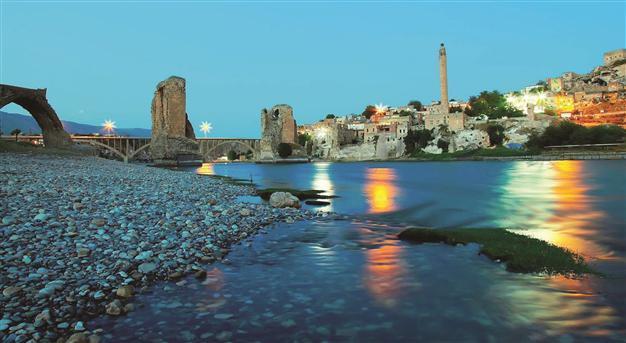Turkish sites shortlisted for Europa Nostra program
THE HAGUE

It will be announced in June if the St George Armenian Church in Mardin and the historic city of Hasankeyf will be listed in the program.
On April 18 the International Day for Monuments and Sites, the leading European heritage organization Europa Nostra revealed 14 monuments and sites in Europe shortlisted in its “Seven Most Endangered” program. Two places from Turkey, the St. George Armenian Church in the eastern province of Mardin and the historic city of Hasankeyf and its surrounding area are included on the list.An international Advisory Panel composed of eminent experts selected these threatened landmarks, including historic city centers, archaeological sites, religious buildings and military fortifications, among 40 nominations submitted by civil society organizations and public bodies from 21 countries.
“With this new advocacy program, Europa Nostra aims not only to identify the most endangered monuments and sites in Europe but also to launch a true call for action. By sending multidisciplinary teams of experts to visit the selected sites, together with our partners, we will seek to contribute to finding sustainable and viable solutions for the future. In this way, we hope to inspire and encourage action by various public and private organizations also in other places in Europe and beyond,” said Denis de Kergorlay, Europa Nostra’s Executive President.
Armenian Church and Hasankeyf
In a written statement, it is said that the nomination of St. George Armenian Church in Mardin, which has foundations going back to the 5th century and which served a large Armenian population until the beginning of the 20th century, reflects the commitment of the heritage community in Turkey to preserve the tangible witnesses of the country’s multi-cultural history.
“The heritage of the ancient town of Mardin reminds us that through the centuries this city has been a melting pot of cultures and religions. Today, this heritage has great potential for sustainable tourism and economic development,” the statement said.
As for the historic city of Hasankeyf and its surroundings, the statement warned about the construction of the Ilısu hydroelectric dam nearby. “If the construction of the Ilısu hydroelectric dam continues as foreseen, 80 percent of Hasankeyf’s historic monuments will be flooded within the next decade. At present there is no internationally recognized scheme for their conservation, preservation or relocation. If it would be spared from inundation, Hasankeyf has the potential to provide a sustainable anchor for local and regional economic development, providing visitors and scholars with a contextualized record of shared human history, spanning the continents of Europe and Asia,” it said.
Among other sites on the shortlist include the Roman Amphitheatre in Durres, Albania; the St. Paul and St. Peter Church, Armenia; the buffer zone of the historic center of Nicosia in Cyprus; Vauban’s Fortifications in Briançon, France; gaslight and gas lamps in Berlin; the former royal estate of Tatoi, near Athens; the citadel of Alessandria, Italy; the renaissance monastery of San Benedetto Po, Italy; a Manueline style monastery and church, Portugal; the Roşia Montana mining landscape in Transylvania, Romania; the Beeolithic archaeological site of Vinca-Belo Brdo, near Belgrade in Serbia; and the neighborhood of El Cabanyal-Canyamelar in Valencia, Spain.
The final list will be announced at Europa Nostra’s 50th Anniversary Congress in Athens on June 16. Rescue missions will be organized and preliminary action plans proposed until December by a team of heritage specialists together with technical and financial experts from the European Investment Bank Group, a founding partner of the program.
‘Seven Most Endangered’ program
The Seven Most Endangered program was launched last January. Its aim is to serve as a catalyst for action and to promote “the power of example.” After the summer, teams composed of heritage experts from Europa Nostra and its member organizations as well as of technical and financial specialists from the European Investment Bank Group or the Council of Europe Development Bank will visit the seven selected monuments and sites.
In close consultation with local stakeholders, they will assess existing problems and sketch viable and sustainable action plans for each one. All rescue missions will report back before the end of the year and the preliminary results are due to be presented at the European Heritage Policy Conference organized by Europa Nostra in Brussels on Dec. 5.
















